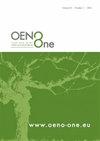哪些微生物会使我们的葡萄酒失去味道?
IF 2.2
3区 农林科学
Q3 FOOD SCIENCE & TECHNOLOGY
引用次数: 0
摘要
近年来,葡萄酒中出现老鼠味的频率越来越高。这可能是由于加工过程中二氧化硫添加量的显著减少,pH值的增加甚至是葡萄酒中自发发酵的趋势造成的。这种异味与布鲁克斯干酪菌或乳酸菌代谢有关。三种n -杂环化合物(APY, ETHP, ATHP)被描述为参与小鼠感知。到目前为止,还没有研究表明不同物种的微生物菌株产生n -杂环的差异。对25种呈现鼠味的葡萄酒进行了分析。共分离鉴定出细菌252株(含90.5%的酒球菌)和酵母菌101株(含53.5%的酿酒酵母)。采用搅拌棒吸附萃取-气相色谱-质谱联用(SBSE-GC-MS)和标准n-杂环测定培养基对它们产生小鼠化合物的能力进行了研究。从小鼠酒中分别分离到4种酵母和3种细菌,只有3种微生物与n -杂环化合物的产生有关:bruxellensis、Lentilactobacillus hilgardii和Oenococcus oeni。然后将筛选扩展到收集这三个物种的菌株,以提高它们的遗传代表性。我们的结果表明,三种n -杂环的含量和比例根据物种的不同而有很大的变化。此外,研究表明,在大多数小鼠酒中,没有发现布鲁塞尔芽孢杆菌。最后,发现了ATHP和ETHP之间有趣的相关性。本文章由计算机程序翻译,如有差异,请以英文原文为准。
Which microorganisms contribute to mousy off-flavour in our wines?
In recent years, the frequency of occurrence of mousy off-flavours in wines has increased. This could be caused by the significant decrease in sulphur dioxide addition during processing, the increase in pH or even the trend for spontaneous fermentation in wine. This off-flavour was associated with Brettanomyces bruxellensis or lactic acid bacteria metabolisms. Three N-heterocyclic compounds (APY, ETHP, ATHP) were described as involved in mousiness perception. Thus far, no study addressed the variability in that N-heterocycles production according to microorganism strains from different species. Twenty-five wines presenting mousy off-flavour were analysed. In total, 252 bacteria with 90.5 % of Oenococcus oeni and 101 yeast strains with 53.5 % of Saccharomyces cerevisiae were isolated and identified. Their capacity to produce mousy compounds was investigated using Stir Bar Sorptive Extraction-Gas Chromatography-Mass Spectrometry (SBSE-GC-MS) and a standardised N-heterocycle assay medium. While four and three species of yeast and bacteria, respectively, were isolated from mousy wines, only three species of microorganisms were associated with N-heterocycles production: B. bruxellensis, Lentilactobacillus hilgardii and Oenococcus oeni. The screening was then extended to collection strains for these three species to improve their genetic representativity. Our results show that the levels and the ratios of the three N-heterocycles present huge variations according to the species. In addition, it has been shown that in most mousy wines, B. bruxellensis was not found. Finally, an interesting correlation between ATHP and ETHP was identified.
求助全文
通过发布文献求助,成功后即可免费获取论文全文。
去求助
来源期刊

OENO One
Agricultural and Biological Sciences-Food Science
CiteScore
4.40
自引率
13.80%
发文量
85
审稿时长
13 weeks
期刊介绍:
OENO One is a peer-reviewed journal that publishes original research, reviews, mini-reviews, short communications, perspectives and spotlights in the areas of viticulture, grapevine physiology, genomics and genetics, oenology, winemaking technology and processes, wine chemistry and quality, analytical chemistry, microbiology, sensory and consumer sciences, safety and health. OENO One belongs to the International Viticulture and Enology Society - IVES, an academic association dedicated to viticulture and enology.
 求助内容:
求助内容: 应助结果提醒方式:
应助结果提醒方式:


